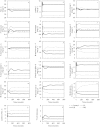Significance of microbial asynchronous anabolism to soil carbon dynamics driven by litter inputs
- PMID: 25849864
- PMCID: PMC4387914
- DOI: 10.1038/srep09575
Significance of microbial asynchronous anabolism to soil carbon dynamics driven by litter inputs
Abstract
Soil organic carbon (SOC) plays an important role in the global carbon cycle. However, it remains largely unknown how plant litter inputs impact magnitude, composition and source configuration of the SOC stocks over long term through microbial catabolism and anabolism, mostly due to uncoupled research on litter decomposition and SOC formation. This limits our ability to predict soil system responses to changes in land-use and climate. Here, we examine how microbes act as a valve controlling carbon sequestrated from plant litters versus released to the atmosphere in natural ecosystems amended with plant litters varying in quantity and quality. We find that litter quality - not quantity - regulates long-term SOC dynamics under different plausible scenarios. Long-term changes in bulk SOC stock occur only when the quality of carbon inputs causes asynchronous change in a microbial physiological trait, defined as "microbial biosynthesis acceleration" (MBA). This is the first theoretical demonstration that the response of the SOC stocks to litter inputs is critically determined by the microbial physiology. Our work suggests that total SOC at an equilibrium state may be an intrinsic property of a given ecosystem, which ultimately is controlled by the asynchronous MBA between microbial functional groups.
Figures



Similar articles
-
Accelerated soil carbon turnover under tree plantations limits soil carbon storage.Sci Rep. 2016 Jan 25;6:19693. doi: 10.1038/srep19693. Sci Rep. 2016. PMID: 26805949 Free PMC article.
-
Microbial models with data-driven parameters predict stronger soil carbon responses to climate change.Glob Chang Biol. 2015 Jun;21(6):2439-53. doi: 10.1111/gcb.12827. Epub 2015 Mar 6. Glob Chang Biol. 2015. PMID: 25504863
-
Tree species selection for optimizing soil carbon storage: Insights from litter decomposition and bacterial community analysis in coastal ecosystems.J Environ Manage. 2024 Nov;370:122984. doi: 10.1016/j.jenvman.2024.122984. Epub 2024 Oct 21. J Environ Manage. 2024. PMID: 39437689
-
Using experimental manipulation to assess the roles of leaf litter in the functioning of forest ecosystems.Biol Rev Camb Philos Soc. 2006 Feb;81(1):1-31. doi: 10.1017/S1464793105006846. Biol Rev Camb Philos Soc. 2006. PMID: 16460580 Review.
-
Effects of simulated warming on content, fractions and chemical structure of soil organic carbon:Progress and prospects.Ying Yong Sheng Tai Xue Bao. 2024 Sep 18;35(9):2432-2444. doi: 10.13287/j.1001-9332.202409.010. Ying Yong Sheng Tai Xue Bao. 2024. PMID: 39435806 Review. English.
Cited by
-
Are variations in heterotrophic soil respiration related to changes in substrate availability and microbial biomass carbon in the subtropical forests?Sci Rep. 2015 Dec 16;5:18370. doi: 10.1038/srep18370. Sci Rep. 2015. PMID: 26670822 Free PMC article.
-
The importance of anabolism in microbial control over soil carbon storage.Nat Microbiol. 2017 Jul 25;2:17105. doi: 10.1038/nmicrobiol.2017.105. Nat Microbiol. 2017. PMID: 28741607 No abstract available.
-
Improved model simulation of soil carbon cycling by representing the microbially derived organic carbon pool.ISME J. 2021 Aug;15(8):2248-2263. doi: 10.1038/s41396-021-00914-0. Epub 2021 Feb 22. ISME J. 2021. PMID: 33619354 Free PMC article.
-
Factors affecting distribution patterns of organic carbon in sediments at regional and national scales in China.Sci Rep. 2017 Jul 14;7(1):5497. doi: 10.1038/s41598-017-06035-z. Sci Rep. 2017. PMID: 28710452 Free PMC article.
References
-
- Eswaran H., Van Den Berg E. & Reich P. Organic carbon in soils of the world. Soil Sci. Soc. Am. J. 57, 192–194, 10.2136/sssaj1993.03615995005700010034x (1993). - DOI
-
- Balser T. C. in Encyclopedia of soils in the environment (ed Hillel D., ed. ) 195–207 (Elsevier, 2005).
-
- Davidson E. A. & Janssens I. A. Temperature sensitivity of soil carbon decomposition and feedbacks to climate change. Nature 440, 165–173 (2006). - PubMed
-
- Rustad L., Huntington T. & Boone R. Controls on soil respiration: Implications for climate change. Biogeochemistry 48, 1–6 (2000).
-
- Liang C. & Balser T. C. Warming and nitrogen deposition lessen microbial residue contribution to soil carbon pool. Nat Commun 3, 1222 (2012). - PubMed
MeSH terms
Substances
LinkOut - more resources
Full Text Sources
Other Literature Sources

